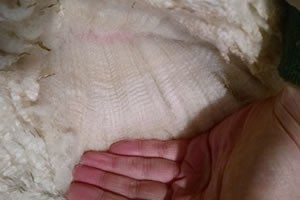Frequently Asked Questions
What is 'skirting'?
Skirting is a process in which the shepherd lays out the shorn fleece on a slatted table and assesses the wool for defects. Since I am a handspinner, and sell my fleeces to other handspinners and fiber artists, I understand the necessity for high quality fiber.
Belly wool is removed, as is VM contaminated neck wool, and wool from the lower legs which were not covered by a sheep coat. Very greasy wool from the armpit areas, and discolored wool from the dock area is also removed.
The fleece is also examined for weak spots and tenderness throughout. Fleeces from animals having had an illness or substantial trauma during the year are given special scrutiny, as an interruption in the normal growth of the wool will cause a weak spot called a 'fever break'.
When the producer is satisfied the fleece is of high quality, it is carefully rolled with the shorn side out, bagged with the sheep's name, weighed, and that information noted in the fleece record book along with a sample lock of the wool.
What is a 'covered' or 'coated' fleece?
These terms refer to a fleece which was literally covered by a coat worn by the sheep while the wool was growing. Many shepherds seeking to produce the highest quality handspinning fleeces possible have adopted the practice of putting lightweight fabric jackets on their animals.
This technique is labor intensive and not cheap, as each animal cycles through a 'wardrobe' of 3 or 4 progressively larger jackets throughout the year as the fleece grows.
Why do I want a covered fleece?
 Wool from sheep who have been coated is superior in every respect to wool which has been exposed to the elements all year. Most importantly, it is completely free of hay chaff, weed seeds and other vegetative matter.
Wool from sheep who have been coated is superior in every respect to wool which has been exposed to the elements all year. Most importantly, it is completely free of hay chaff, weed seeds and other vegetative matter.
Carding can not remove all contaminants from a fleece, so it is much smarter (and will yield a MUCH more satisfactory result) to work with covered fleece in the first place. Secondly, bleaching by the sun is avoided. This is especially obvious on colored fleeces. If you want a black fleece, you do not want the outer 2 inches to have faded to brown. A covered fleece insures that the color of each lock will be the same from butt to tip. Third, a coated fleece will have suffered little or no staining. A year of laying down on the ground and in the barn will often result in stains on uncovered wool along the sides and hind quarters.
A coat provides protection from staining elements and yields a greater quantity of high quality fleece. Once a handspinner enjoys the benefits of working with a coated fleece, they do not willingly go back to working with uncoated wool.
How much wool do I need to make a sweater?
Wow! This has a lot of variables. Is the sweater for a child or a linebacker? Are you knitting a lace pattern, or weaving a rugged fabric for an outdoorsman?
In general, a long-sleeved knitted sweater for an averaged sized adult will take upwards of 2 pounds of yarn. This is a generous quantity, and it is a good rule of thumb to buy more than you think you will need. Nothing is worse than being 95% done with a project, needing more yarn, and finding there is no more of that fleece left to spin from!
How much wool will I be left with after I wash my fleece?
This is a great question to think about, especially if you're buying wool with a specific purpose in mind. Providing that the fleece has already been covered and well-skirted, you can expect to lose 25% of the weight in washing, maybe more depending on the breed of sheep.
Very fine wooled breeds, like Merino and Rambouillet, have more grease in their fleeces, and a greater percentage of weight will be lost to washing. This does not imply fleeces of these breeds are less valuable per pound! It costs the shepherd just as much to produce a high quality fine wool fleece as any other grade, and each grade of wool has uses for which other grades are not as suitable.
How much wool does a sheep produce in a year?
This answer will vary, too. There are many breeds of sheep, and crossbreeds, and mature sizes range from about 100 pounds (Shetlands) to over 300 pounds (Columbias). Quantities of fleece per animal will vary appropriately, from 3-5 pounds for the smaller breeds, to upwards of 20 pounds, particularly from long wool breeds such as Cotswolds and Lincolns, which can grow wool at a rate of an inch per month. These breeds are often shorn every 6 to eight months. A full 12 months growth is often difficult to preserve in perfect condition, as the animals will want to rub when they become uncomfortably warm, and the fleece will start to felt.
